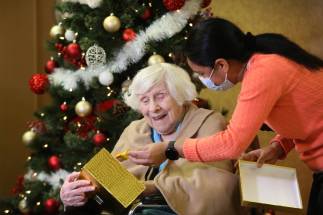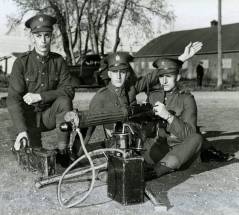Manitobans’ sacrifice remembered 80 years after fall of Hong Kong
Read this article for free:
or
Already have an account? Log in here »
To continue reading, please subscribe:
Monthly Digital Subscription
$0 for the first 4 weeks*
- Enjoy unlimited reading on winnipegfreepress.com
- Read the E-Edition, our digital replica newspaper
- Access News Break, our award-winning app
- Play interactive puzzles
*No charge for 4 weeks then price increases to the regular rate of $19.00 plus GST every four weeks. Offer available to new and qualified returning subscribers only. Cancel any time.
Monthly Digital Subscription
$4.75/week*
- Enjoy unlimited reading on winnipegfreepress.com
- Read the E-Edition, our digital replica newspaper
- Access News Break, our award-winning app
- Play interactive puzzles
*Billed as $19 plus GST every four weeks. Cancel any time.
To continue reading, please subscribe:
Add Free Press access to your Brandon Sun subscription for only an additional
$1 for the first 4 weeks*
*Your next subscription payment will increase by $1.00 and you will be charged $16.99 plus GST for four weeks. After four weeks, your payment will increase to $23.99 plus GST every four weeks.
Read unlimited articles for free today:
or
Already have an account? Log in here »
Hey there, time traveller!
This article was published 23/12/2021 (1448 days ago), so information in it may no longer be current.
Eighty years ago, the Agerbak brothers of Pilot Mound were in the middle of war, thousands of miles from home, and witnesses to the fall of Hong Kong to Japanese forces.
The eldest was Borge, the middle brother was Tage, and the youngest was Knud. They were farm boys, each in their 20s and looking to help the war effort while also earning a steady pay to send their families during an unsteady time.
So they signed up to join the Winnipeg Grenadiers, and after a few postings elsewhere, were bound for the Pacific front.
“A lot of it was patriotism, and a lot of it was desperation (of the economic times),” says Carol Hadley, daughter of Borge, whose cohort called him “Buster” and referred to his brothers as “Tiger” and “Ken.”

The Grenadiers — along with the Royal Rifles from Quebec and the Indian Army’s Rajput Regiment — arrived in Hong Kong to provide reinforcements for the British, who were prepping for battle. The Winnipeg contingent got there in November 1941, and for a few weeks, they enjoyed their time, taking rickshaw rides and seeing the city.
But on Dec. 8, as Japanese forces attacked Pearl Harbor on the other end of the Pacific Ocean, a simultaneous surprise attack happened on the Hong Kong colony.
The allied forces fought for 17 days — nearly 15,000 against nearly 30,000 Japanese.
On Christmas Day, Hong Kong fell, with an estimated 2,113 allied and 675 Japanese troops killed.
On Christmas Day, Hong Kong fell, with an estimated 2,113 allied and 675 Japanese troops killed.
About 10,000 troops who survived became prisoners of war, forced to work in shipyards and mines, starved, tortured and deprived of medical care.
They sabotaged the enemy when they could, poorly mixing concrete with the goal local tarmacs would crumble as Japanese planes landed. Along with the men were two nurses, May Waters from St. Vital and Kay Christie from Toronto, the only female POWs, Hadley says.
The Dec. 29, 1941 edition of the Winnipeg Free Press wrote: “Among the defenders of Hong Kong who made such a name for themselves in the heroic stand of empire forces, which was finally ended on Christmas Day, the men of Pilot Mound, Manitoba were well-represented.”
There were 12 Pilot Mound residents who fought in Hong Kong: Guy Stewart, Jack Fordyce, Jack Hay, Bill Mayne, Ed Toews, Buzz Winram, Dick Currie, Ed Currie, Keith Stewart, and the Agerbaks.
Borge and Knud were in the same company and taken prisoner, but their brother was deemed missing. Tage Agerbak’s fate was unknown until the early 1950s, when he was officially declared killed in action.

For four years, the allies were imprisoned, eating 1,000 calories or less every day. They were kept in the type of conditions designed not just to break men, but shatter them. When the Japanese surrendered in August 1945, the men woke up one morning to find no guards, and presumed the war was over, Hadley says.
Borge, who joined the war effort with a heft of 180 pounds, now weighed 100.
No prisoner who survived imprisonment escaped unscathed: their bodies were, in many cases, irrevocably damaged; their minds often saddled with the unbearable weight of post-traumatic stress.
“It’s hard to forget an experience like that,” Borge Agerbak told the Free Press in 1997.
The memories of war rendered December — what for many is a celebratory period — somber, says Hadley, who was born in 1946 and now serves as the Prairie regional director of the Hong Kong Veterans Commemorative Association.
“It’s hard to forget an experience like that.” – Borge Agerbak
Her parents, particularly mother Evelyn, did their best to make the holidays happy. However, her father would often need time to sit and quietly reflect on what he had lost in Hong Kong on Christmas Day 1941.
Many veterans of the battle had similar experiences, and for years, spoke only amongst themselves about what had happened. Over time, Hadley says, they realized they needed to share their stories because too few understood what they’d experienced.
They wanted to erect monuments, to have their stories taught in schools. They wanted the surviving widowers and families to be looked after. To that end, the commemorative association was founded in 1995.
Hadley’s parents returned to Hong Kong every five years to pay tribute to Tage, visiting the spot in the Sai Wan Cemetery where his name is memorialized. In 2000, Hadley and her brother accompanied their father and his colleagues to see the places they’d once seen through younger eyes.
“It was amazing to hear these men talk,” Hadley says.
“It was amazing to hear these men talk.” – Carol Hadley, daughter of Borge
They’d tried hard to conceal the horrific memories from their families, but in Hong Kong, they walked together and often broke out in laughter, recalling inside jokes from their days as saboteurs.
Both Borge and Knud Agerbak died in 2001. In the two decades since, the number of Canadian survivors of the Battle of Hong Kong have been winnowed down year by year.
In September, the last surviving Winnipeg Grenadier, George Peterson, died at age 100. (He was a member of the Arden Seven, a group of friends and brothers from St. Vital’s Arden Avenue who survived the battle and were taken prisoner.)
Out of the nearly 2,000 Canadian soldiers who fought in Hong Kong, only four are still living. The youngest will turn 100 next summer; the oldest will turn 105 in April.
Eighty years ago, they were young men who found themselves in the middle of war.
ben.waldman@freepress.mb.ca

Ben Waldman covers a little bit of everything for the Free Press.
Our newsroom depends on a growing audience of readers to power our journalism. If you are not a paid reader, please consider becoming a subscriber.
Our newsroom depends on its audience of readers to power our journalism. Thank you for your support.








